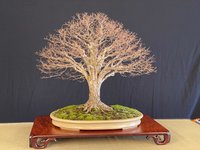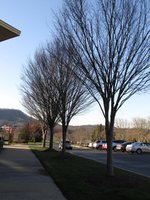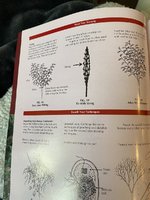Hack Yeah!
Omono
Any of your cuttings take?



Allow me to add to this thread about how to develop Zelkova…
When growing out young Zelkova, don’t wire out any branches to be horizontal. They should ALL be positioned to grow up. Bobby shows a tree he’s working on up above in this thread, and he has the lowest branches wired out horizontally. That’s a mistake. Old Zelkova will develop some low horizontals, but that something that will happen on its own far out into the future. Young stock should be developed to have the branches growing upwards in a Y orientation.
I’m sorry, but I don’t know what a “Pall style” Zelkova should look like. All I know is that Zelkova, aka Japanese Grey Bark Elm, naturally grow into broom style trees. Some have a bazillion branches that all seem to emanate from a single height on the trunk, some will have a central trunk with a bazillion branches growing up all around. “Pine tree” styles are not a natural form for Zelkova.Kind of depends on what style of tree one is after though, doesn't it? If you want a "standard" broom style zelkova or a more informal "Pall style" broom, then I'd agree with you about wiring branches upward (or allowing them to grow that way if that's what they're doing). But if you want more of a "bonsai" or (heaven forbid) "pine" style, then maybe you want to wire the young branches out horizontally or even down a bit.
I think people tend to wire young deciduous trees out horizontally almost reflexively sometimes, without thinking about the future (though I'm not saying Bobby is doing this). I find myself drawn more to deciduous trees that have upward growing branches or subtrunks as these look more like real deciduous trees to me. To each his own, though. I do think people should be encouraged to at least think about it before wiring those branches.

Interesting….When I say "Pall style" I'm referring to what others might call a naturalistic broom. Not a tree that has all the branches coming from one spot and not a tree that has a single leader with branches coming off it. Instead, a tree that has one trunk that divides into 2 or more subtrunks from which branches grow. Something like the tree below, an image taken from Jonas's recent book. I believe the tree belongs to Eric Schrader.
View attachment 414112





Well, many deciduous trees grow, naturally, into the broom style form. But Zelkova are especially good at it. They form slender branches and fine twigging, their leaves will shrink to scale, they form naturally radial buttracing nebari, etc. And they naturally grow as brooms. That’s “naturalistic” for them. And their branches sweep upward, not outward. Especially as young trees.I don't think this is derailing the thread at all. We are talking about styling considerations which should/could be taken into account with my tree and others as well.
Adair, do you believe that a tree should only be styled like what it looks like in nature? If so, how would you recommend I proceed with my tree to get into the broom style you are citing as the "proper" form for a Zelkova?


First congratulations on the award @Adair M! I don't have Zelkova, but I picked up three little (2-3 yr old) Chinese elms this year. I have found similar info to your last post and wanted to implement these techniques with two of my elms. My question is do I need to wait for the leaves to drop or should I just defoliate, trim and tie them up now? We just had our first, maybe only, snow of the year and looks like we're getting back into the high 40s this week.Well, many deciduous trees grow, naturally, into the broom style form. But Zelkova are especially good at it. They form slender branches and fine twigging, their leaves will shrink to scale, they form naturally radial buttracing nebari, etc. And they naturally grow as brooms. That’s “naturalistic” for them. And their branches sweep upward, not outward. Especially as young trees.
What I see in Eric’s tree, and in Bobby Lane’s is an attempt to make a young tree look old by pulling branches down into horizontal positions. That’s USUALLY a good approach, but unfortunately, not with Zelkova. Your tree is being pulled down, too. Zelkova take years (decades) to develop. But the way it’s done best is to work WITH their natural growth habit, not AGAINST it. So, if anything, the branches should be encouraged to grow UP not OUT.
In Japan, they actually tie the young trees up like how the Christmas trees are tied on the way to market! They tie them with raffia over the winter to assure the branches will grow up, not out. Then, as they mature over the years, the canopy slowly spreads out into a Y or vase shape.
Here are some diagrams:
View attachment 414160
With time, a young Zelkova will resemble something like this:
View attachment 414161
As you can see, no horizontal branches.
As for whether it’s correct or advisable to style one species of tree to take on the shape of another species… Well, bonsai IS an art form. And if it is the intention of the artist to do that, well, that’s the artist’s intention. But, I’m not at all sure that always is the artist’s intent. I think sometimes that a tree gets styled to look like a different species because the artist doesn’t know how it’s supposed to look, or employs the wrong technique when training, or just doesn’t care.
Now, I think there are times when it’s perfectly acceptable to use one species to represent another. Let’s say you wanted to make a bonsai of a Southern Magnolia. Well, you can’t. The leaves just wont reduce to scale. So, you might use a boxwood or azalea to look like a Southern Magnolia.
A comment about “Naturalistic”… @coh stated that Eric’s tree looked “naturalistic”. I wonder why he says that? Is it because it has some structural flaws? (Trees in nature often have structural elements that we bonsaiists would call “flaws”). Or is it because it is more random with twigs going off in all different directions? Whereas the classic zelkova brooms are more uniform with branches and twigs sweeping up and out in a more uniform manner? Does this randomness equal “naturalistic”? I say no. Zelkova on their own develop the slender, uniform brooms. A craggy style for a zelkova is NOT naturalistic, it is artificial, forced.
Everyone has an image of what THEY think trees should look like. One of my first introductions to Zelkova came from the little Brooklyn Botanical Garden Handbook where there was an article on how to grow them from seed. And that’s the image that sticks with me. I suppose others might have different images in mind.
I got into this hobby so I could play with scissorsYes, defoliate by trimming the leaves off with scissors. I know, it’s a pain to do! Then you can tie them up.
A comment about “Naturalistic”… @coh stated that Eric’s tree looked “naturalistic”. I wonder why he says that?
Yeah, it’s a broom alright, an oak broom. Whether it’s a formal or informal broom, I suppose that’s a whole different topic! LOL!!! Personally, I have always held “Broom” as being part of the “Formal Upright” category. (Straight, vertical trunk, apex over the nebari).I actually misspoke (or mistyped). I meant to say "informal broom", not naturalistic. Must have been the egg nog. Anyway, whether that makes any difference to you, I don't know but I really don't have any interest in discussing it further. To each his own.
But for the record...I like Eric's tree. It looks like many natural native trees I've seen in the eastern US. It's not "finished" yet and maybe doesn't look like a typical zelkova in nature, but that doesn't really matter to me. Now I'm done
